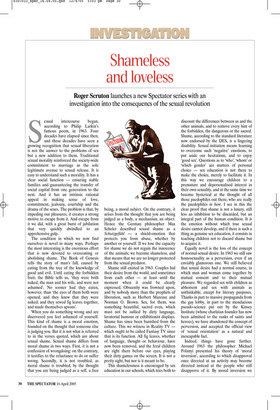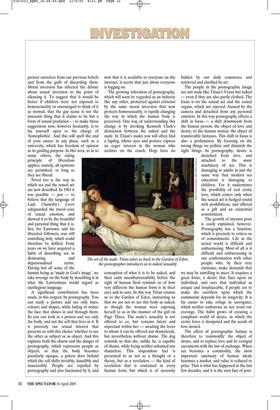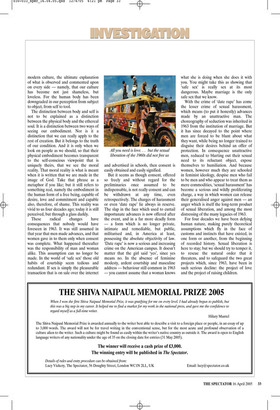Shameless and loveless
Roger Scruton launches a new Spectator series with an investigation into the consequencs of the sexual revolution Sexual intercourse began, according to Philip Larkin’s famous poem, in 1963. Four decades have elapsed since then, and these decades have seen a growing recognition that sexual liberation is not the answer to the problems of sex but a new addition to them. Traditional sexual morality reinforced the society-wide commitment to marriage as the sole legitimate avenue to sexual release. It is easy to understand such a morality. It has a clear social function — ensuring stable families and guaranteeing the transfer of social capital from one generation to the next. And it has an intrinsic rational appeal in making sense of love, commitment, jealousy, courtship and the drama of the sexes. The problem is that, by impeding our pleasures, it creates a strong motive to escape from it. And escape from it we did, with a great burst of jubilation that very quickly dwindled to an apprehensive gulp.
The condition in which we now find ourselves is novel in many ways. Perhaps the most interesting is the enormous effort that is now devoted to overcoming or abolishing shame. The Book of Genesis tells the story of man’s fall, caused by eating from the tree of the knowledge of good and evil. Until eating the forbidden fruit, the Bible tells us, ‘they were both naked, the man and his wife, and were not ashamed’. No sooner had they eaten, however, than ‘the eyes of them both were opened, and they knew that they were naked; and they sewed fig leaves together, and made themselves aprons’.
When you do something wrong and are discovered you feel ashamed of yourself. This kind of shame is a moral emotion, founded on the thought that someone else is judging you. But it is not what is referred to in the verses quoted, which are about sexual shame. Sexual shame differs from moral shame in two ways. First, it is not a confession of wrongdoing: on the contrary, it testifies to the reluctance to do or suffer wrong. Secondly, it is not troubled, as moral shame is troubled, by the thought that you are being judged as a self, a free being, a moral subject. On the contrary, it arises from the thought that you are being judged as a body, a mechanism, an object. Hence the German philosopher Max Scheler described sexual shame as a Schutzgefühl — a shield-emotion that protects you from abuse, whether by another or yourself. If we lose the capacity for shame we do not regain the innocence of the animals; we become shameless, and that means that we are no longer protected from the sexual predator.
Shame still existed in 1963. Couples hid their desire from the world, and sometimes from each other — at least until the moment when it could be clearly expressed. Obscenity was frowned upon, and by nobody more than the prophets of liberation, such as Herbert Marcuse and Norman O. Brown. Sex, for them, was something beautiful, sacred even, which must not be sullied by dirty language, lavatorial humour or exhibitionist displays. Shame has since been banished from the culture. This we witness in Reality TV which ought to be called Fantasy TV since that is its function. All fig leaves, whether of language, thought or behaviour, have now been removed, and the feral children are right there before our eyes, playing their dirty games on the screen. It is not a pretty sight, but nor is it meant to be.
This shamelessness is encouraged by sex education in our schools, which tries both to discount the differences between us and the other animals, and to remove every hint of the forbidden, the dangerous or the sacred. Shame, according to the standard literature now endorsed by the DES, is a lingering disability. Sexual initiation means learning to overcome such ‘negative’ emotions, to put aside our hesitations, and to enjoy ‘good sex’. Questions as to ‘who’, ‘whom’ or ‘which gender’ are matters of personal choice — sex education is not there to make the choice, merely to facilitate it. In this way we encourage children to a premature and depersonalised interest in their own sexuality, and at the same time we become hysterical at the thought of all those paedophiles out there, who are really the paedophiles in here. I see in this the clear proof that shame is not a luxury, still less an inhibition to be discarded, but an integral part of the human condition. It is the emotion without which true sexual desire cannot develop, and if there is such a thing as genuine sex education, it consists in teaching children not to discard shame but to acquire it.
Equally novel is the loss of the concept of normal sexual desire. In 1963 we still saw homosexuality as a perversion, even if an enviably glamorous one. We still believed that sexual desire had a normal course, in which man and woman come together by mutual consent and to their mutual pleasure. We regarded sex with children as abhorrent and sex with animals as unthinkable, except for literary purposes. Thanks in part to massive propaganda from the gay lobby, in part to the mendacious pseudo-science put out by the Kinsey Institute (whose charlatan founder has now been admitted to the ranks of saints and heroes), we have abandoned the concept of perversion, and accepted the official view of ‘sexual orientation’ as a natural and inescapable fact.
Indeed, things have gone further. Around 1963 the philosopher Michael Polanyi presented his theory of ‘moral inversion’, according to which disapproval once directed at an activity may become directed instead at the people who still disapprove of it. By moral inversion we protect ourselves from our previous beliefs and from the guilt of discarding them. Moral inversion has infected the debate about sexual inversion to the point of silencing it. To suggest that it would be better if children were not exposed to homosexuality or encouraged to think of it as normal, that the gay scene is not the innocent thing that it claims to be but a form of sexual predation — to make those suggestions now, however hesitantly, is to lay yourself open to the charge of ‘homophobia’. And this will spell the end of your career in any place, such as a university, which has freedom of opinion as its guiding purpose. In this area, as in so many others, the ruling principle of liberalism applies; namely, all opinions are permitted, so long as they are liberal.
Novel too is the way in which sex and the sexual act are now described. In 1963 it was possible — just — to believe that the language of Lady Chatterley’s Lover safeguarded the moral core of sexual emotion, and showed it to be the beautiful and personal thing that it is. Sex, for Lawrence and his liberated followers, was still something holy, which could therefore be defiled. Forty years on we have acquired a habit of describing sex in demeaning and depersonalised terms.
Having lost all sense of the human being as ‘made in God’s image’, we take revenge on the body by describing it in what the Lawrentians would regard as sacrilegious language.
A significant contribution has been made, in this respect, by pornography. You can study a picture and see only lines, colours and shapes, while failing to notice the face that shines in and through them. So you can look at a person and see only the body, and not the self that lives in it. It is precisely our sexual interest that presents us with this choice: whether to see the other as subject or as object. And this explains both the charm and the danger of pornography, which represents people as objects, so that the body becomes peculiarly opaque, a prison door behind which the self shifts invisibly, inaudibly and inaccessibly. People are repelled by pornography and also fascinated by it, and now that it is available to everyone on the internet, it seems that just about everyone is logging on.
The growing toleration of pornography, which will soon be regarded as an industry like any other, protected against criticism by the same moral inversion that now protects homosexuality, is rapidly changing the way in which the human body is perceived. One way of understanding this change is by invoking Kenneth Clark’s distinction between the naked and the nude. In Titian’s nudes you will often find a lapdog, whose eyes and posture express an eager interest in the woman who reclines on the couch. Dogs have no conception of what it is to be naked, and their calm unembarrassability before the sight of human flesh reminds us of how very different the human form is in their eyes and in ours. In this way Titian returns us to the Garden of Eden, instructing us that we are not to see this body as naked, as though the woman were exposing herself to us in the manner of the girl on Page Three. The nude’s sexuality is not offered to us, but remains latent and expectant within her — awaiting the lover to whom it can be offered not shamelessly, but nevertheless without shame. The dog reminds us that she, unlike he, is capable of shame, while being neither ashamed nor shameless. This stupendous fact is presented to us not as a thought or a theory, but as a revelation — the kind of revelation that is contained in every human form, but which is of necessity hidden by our daily commerce and retrieved and clarified by art.
The people in the pornographic image are not nude like Titian’s Venus but naked — even if they are also partly clothed. The focus is on the sexual act and the sexual organs, which are exposed, framed by the camera and detached from any personal emotion. In this way pornography effects a shift in focus — a shift downwards from the human person, the object of love and desire, to the human animal, the object of transferable fantasies. This shift in focus is also a profanation. By focusing on the wrong things we pollute and diminish the right things. In pornography, desire is detached from love, and attached to the mute machinery of sex. This is damaging to adults in just the same way that modern sex education is damaging to children. For it undermines the possibility of real erotic love, which comes only when the sexual act is hedged round with prohibitions, and offered as a gift and an existential commitment.
The growth of internet porn is easily explained, however. Pornography has a function, which is precisely to relieve us of commitments. Life in the actual world is difficult and embarrassing. Most of all is it difficult and embarrassing in our confrontation with other people who, by their very existence, make demands that we may be unwilling to meet. It requires a great force, a desire that fixes upon an individual, and sees that individual as unique and irreplaceable, if people are to make the sacrifices upon which the community depends for its longevity. It is far easier to take refuge in surrogates, which neither embarrass us nor resist our cravings. The habit grows of creating a compliant world of desire, in which the erotic force is dissipated and the needs of love denied.
The effect of pornographic fantasy is therefore to ‘commodify’ the object of desire, and to replace love and its vestigial sacraments with the law of exchange. When sex becomes a commodity, the most important sanctuary of human ideals becomes a market, and value is reduced to price. That is what has happened in the last few decades, and it is the root fact of post
Titian’s ‘Venus of Urbino’, Uffizi Gallery, Florence
modern culture, the ultimate explanation of what is observed and commented upon on every side — namely, that our culture has become not just shameless, but loveless. For the human body has been downgraded in our perception from subject to object, from self to tool.
The distinction between body and self is not to be explained as a distinction between the physical body and the ethereal soul. It is a distinction between two ways of seeing our embodiment. Nor is it a distinction that we can really apply to the rest of creation. But it belongs to the truth of our condition. And it is only when we look on people as we should, so that their physical embodiment becomes transparent to the self-conscious viewpoint that is uniquely theirs, that we see the moral reality. That moral reality is what is meant when it is written that we are made in the image of God. Take that phrase as a metaphor if you like; but it still refers to something real, namely the embodiment in the human form of a free being, capable of desire, love and commitment and capable also, therefore, of shame. This reality was vivid to us four decades ago; today it is still perceived, but through a glass darkly.
These radical changes have consequences that nobody would have foreseen in 1963. It was still assumed in that year that men made advances, and that women gave in to them only when consent was complete. What happened thereafter was the responsibility of man and woman alike. This assumption can no longer be made. In the world of ‘safe sex’ those old habits of courtship seem tedious and redundant. If sex is simply the pleasurable transaction that is on sale over the internet and advertised in schools, then consent is easily obtained and easily signified.
But it seems as though consent, offered so freely and without regard for the preliminaries once assumed to be indispensable, is not really consent and can be withdrawn at any time, even retrospectively. The charges of harassment or even ‘date rape’ lie always in reserve. The slap in the face which used to curtail importunate advances is now offered after the event, and in a far more deadly form — a form which is no longer private, intimate and remediable, but public, militarised and, in America at least, possessing the absolute objectivity of law. ‘Date rape’ is now a serious and increasing crime on the American campus. It doesn’t matter that the girl said ‘yes’, since yes means no. In the absence of feminine modesty, ardent courtship and masculine address — behaviour still common in 1963 — you cannot assume that a woman knows what she is doing when she does it with you. You might take this as showing that ‘safe sex’ is really sex at its most dangerous. Maybe marriage is the only safe sex that we know.
With the crime of ‘date rape’ has come the lesser crime of sexual harassment, which means (to put it honestly) advances made by an unattractive man. The choreography of seduction was inherited in 1963 from the institution of marriage. But it has since decayed to the point where men are forced to be blunt about what they want, while being no longer trained to disguise their desires behind an offer of protection. In consequence unattractive men, reduced to blurting out their sexual need to its reluctant object, expose themselves to humiliation. And because women, however much they are schooled in feminist ideology, despise men who fail to be men and who appear to treat them as mere commodities, ‘sexual harassment’ has become a serious and wildly proliferating charge, a way in which women can release their generalised anger against men — an anger which is itself the long-term product of sexual liberation, and among the most distressing of the many legacies of 1963.
For four decades we have been defying human nature, making purely theoretical assumptions which fly in the face of customs and instincts that have existed, in one form or another, from the beginning of recorded history. Sexual liberation is here to stay; but we should try to temper it, to rescue the natural order that it threatens, and to safeguard the two great projects which, since 1963, have been in such serious decline: the project of love and the project of raising children.


























































 Previous page
Previous page